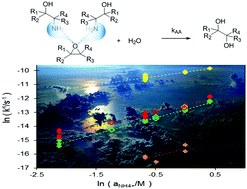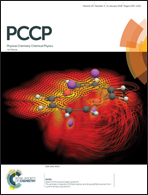The hydrolysis of epoxides catalyzed by inorganic ammonium salts in water: kinetic evidence for hydrogen bond catalysis†
Abstract
Naturally-occurring inorganic ammonium ions have been recently reported as efficient catalysts for some organic reactions in water, which contributes to the understanding of the chemistry in some natural environments (soils, seawater, atmospheric aerosols, …) and biological systems, and is also potentially interesting for green chemistry as many of their salts are cheap and non-toxic. In this work, the effect of NH4+ ions on the hydrolysis of small epoxides in water was studied kinetically. The presence of NH4+ increased the hydrolysis rate by a factor of 6 to 25 compared to pure water and these catalytic effects were shown not to result from other ions, counter-ions or from acid or base catalysis, general or specific. The small amounts of amino alcohols produced in the reactions were identified as the actual catalysts by obtaining a strong acceleration of the reactions when adding these compounds directly to the epoxides in water. Replacing the amino alcohols by other strong hydrogen-bond donors, such as trifluoroethanol (TFE) or hexafluoroisopropanol (HFIP) gave the same results, demonstrating that the kinetics of these reactions was driven by hydrogen-bond catalysis. Because of the presence of many hydrogen-bond donors in natural environments (for instance amines and hydroxy-containing compounds), hydrogen-bond catalysis is likely to contribute to many reaction rates in these environments.



 Please wait while we load your content...
Please wait while we load your content...